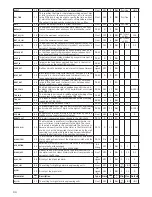
32
This status is a copy of IN’s status unless IN is good and there is a PV or block alarm.
The full cascade SP sub-function is used, with rate and absolute limits. There are additional
control options which will cause the SP value to track the PV value when the block is in an ac-
tual mode of IMan, LO, Man or ROut. Limits do not cause SP-PV tracking.
There is a switch for BYPASS, which is available to the operator if the Bypass Enable control
option is true. Bypass is used in secondary cascade controllers that have a bad PV. The Bypass
Enable option is necessary because not all cascade control schemes will be stable if BYPASS is
true. BYPASS can only be changed when the block mode is Man or O/S. While it is set, the value
of SP, in percent of range, is passed directly to the target output, and the value of OUT is used
for BKCAL_OUT. When the mode is changed to Cas, the upstream block is requested to initial-
ize to the value of OUT. When a block is in Cas mode, then on the transition out of bypass, the
upstream block is requested to initialize to the PV value, regardless of the »Use PV for BKCAL_
OUT« option.
GAIN, RESET, and RATE are the tuning constants for the P, I, and D terms, respectively. Gain is
a dimensionless number. RESET and RATE are time constants expressed in seconds. There are
existing controllers that are tuned by the inverse value of some or all of them, such as propor-
tional band and repeats per minute. The human interface to these parameters should be able
to display the user’s preference. The Direct Acting control option, if true, causes the output to
increase when the PV exceeds the SP. If false, the output will decrease when the PV exceeds
the SP. It will make the difference between positive and negative feedback, so it must be set
properly, and never changed while in an automatic mode. The setting of the option must also
be used in calculating the limit state for BKCAL_OUT.
The output supports the feed forward algorithm. The FF_VAL input brings in an external value
which is proportional to some disturbance in the control loop. The value is converted to per-
cent of output span using the values of parameter FF_SCALE. This value is multiplied by the
FF_GAIN and added to the target output of the PID algorithm. If the status of FF_VAL is Bad,
the last usable value will be used, because this prevents bumping the output. When the status
returns to good, the block will adjust its integral term to maintain the previous output.
The output supports the track algorithm.
There is an option to use either the SP value after limiting or the PV value for the BKCAL_OUT
value..
4.5 Supported Modes
O/S, IMan, LO, Man, Auto, Cas, RCas, and ROut.
4.6 Alarm Types
Standard block alarm plus standard HI_HI, HI, DV_HI, DV_LO, LO, and LO_LO alarms applied to
PV.
4.7 Mode Handling
Standard transition in and out of O/S.
4.8 Status Handling
Standard, plus the following things for the control selector If Not selected is received at
BKCAL_IN, the PID algorithm should make necessary adjustments to prevent windup.
4.9 Initialization
Standard.






































